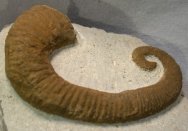
The reason for the nautilus’ greater depth tolerance, while retaining simple sutures, is simply that they have thicker shells than the ammonites, which evolved a different way of strengthening themselves. This may be true, but it has been shown that nautiluses can (and did) dive deeper than ammonites, but these animals have very uncomplicated suture lines. It is thought that ammonites had these complex interlocking chamber shapes to give the shell more strength, so that the animal could dive to greater depths without being crushed by water pressure. The shapes of the lines are often used to aid in taxonomy. Sutures are intricate patterns that run across the whorls and show how the outer edges of an ammonite’s chambers fit together. Sometimes, these are not easy to see, but that does not mean they are not present – all ammonites have them.

Lappets and spines (at the aperture) – protrusions extending from the opening of the ammonite shell.Īn internal mould will show all of the above ornamentation, if present in the actual shell (except for the lappets and spines at the aperture, and the growth lines), along with the addition of suture lines.Keel(s) – structures that adorn the outer edge of an ammonite’s whorls.

Tubercles – a name for a variety of protrusions that extend from the ribs, including spine bases, where the spine has been lost.Spines – protrusions extending from the ribs that taper to a point.Knobs – spherical structures that extend from ribs in places.Ribbing – ribs running across the whorls.In cases where the shell does survive, mineralisation of this can lead to some beautiful ammonite specimens, for example, those of the Gault Clay in England and the Bearpaw Formation of Canada and the USA.Īmmonite shells often have ornamentation, consisting of some or all of the following: These are basically a copy of what the outside of the shell looked like, only a tiny bit smaller. The actual aragonite shell of the ammonite creature is often lost during fossilisation, to leave us with internal mould fossils. Heteromorph ammonites had a variety of shapes, including the basic ammonite spiral, only uncoiled (each new whorl not touching the last), a spiral that became significantly uncoiled in the lead up to the animal becoming mature, and upwards coiling spirals, like the type we see in snail shells, to mention but a few. If it does not, the specimen is said to be ‘evolute’ (for example, Dactylioceras). If the outer whorl of an ammonite shell largely covers the preceding whorls, the specimen is said to be ‘involute’ (for example, Anahoplites). Some are fairly square (for example, Acanthoceras), while others are more rounded (for example, Dactylioceras) and some very slim (for example, Placenticeras). In transverse cross section, the whorls of different ammonite species can show various profiles. In other words, they are generally a flattish spiral, which gets thicker with each whorl.

The shell – generalĪmmonite shells (apart from in the heteromorphs) all follow a similar basic design, which is that of an expanding cone, spiralling around a centre point, in a single plane. The deeply incised sutural elements are asymmetric, including the double-pronged ventral lobe.Ĭretaceous of Egypt, Iraq, British Columbia, California, Colorado, Delaware, Montana, New Mexico, Wyoming.Ammonites (Ammonitida) were shelled cephalopod molluscs that lived throughout the world’s oceans during the Mesozoic (Triassic, Jurassic and Cretaceous periods) and they were an extremely successful order, as evidenced by the frequency with which their remains are found. Most end with a tubule on the ventrolateral shoulder. The ribs may be straight or flexuous and mostly slant. The whorl section is ovate with the dorsum on the inside curve broader than the venter on the outside. Įxiteloceras was proposed by Alpheus Hyatt in 1894 for heteromorph ammonites with shells that are loosely coiled in a plane, early whorls varying from straight limbs connected by semicircular elbows to elliptical or nearly circular loops, later whorls being elliptical to circular. Exiteloceras is an ammonite genus from the Late Cretaceous.


 0 kommentar(er)
0 kommentar(er)
